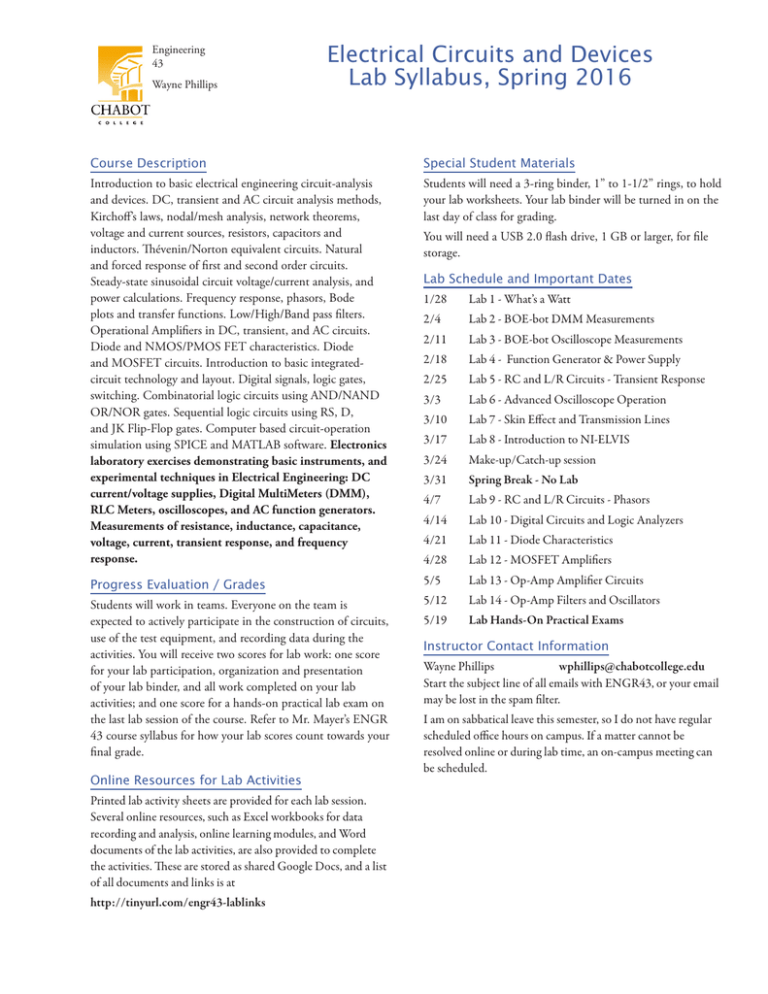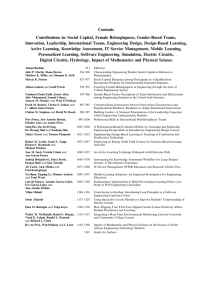Course Description Special Student Materials Introduction to basic electrical engineering circuit-analysis
advertisement

Engineering 43 Wayne Phillips Electrical Circuits and Devices Lab Syllabus, Spring 2016 Course Description Special Student Materials Introduction to basic electrical engineering circuit-analysis and devices. DC, transient and AC circuit analysis methods, Kirchoff’s laws, nodal/mesh analysis, network theorems, voltage and current sources, resistors, capacitors and inductors. Thévenin/Norton equivalent circuits. Natural and forced response of first and second order circuits. Steady-state sinusoidal circuit voltage/current analysis, and power calculations. Frequency response, phasors, Bode plots and transfer functions. Low/High/Band pass filters. Operational Amplifiers in DC, transient, and AC circuits. Diode and NMOS/PMOS FET characteristics. Diode and MOSFET circuits. Introduction to basic integratedcircuit technology and layout. Digital signals, logic gates, switching. Combinatorial logic circuits using AND/NAND OR/NOR gates. Sequential logic circuits using RS, D, and JK Flip-Flop gates. Computer based circuit-operation simulation using SPICE and MATLAB software. Electronics laboratory exercises demonstrating basic instruments, and experimental techniques in Electrical Engineering: DC current/voltage supplies, Digital MultiMeters (DMM), RLC Meters, oscilloscopes, and AC function generators. Measurements of resistance, inductance, capacitance, voltage, current, transient response, and frequency response. Students will need a 3-ring binder, 1” to 1-1/2” rings, to hold your lab worksheets. Your lab binder will be turned in on the last day of class for grading. You will need a USB 2.0 flash drive, 1 GB or larger, for file storage. Lab Schedule and Important Dates 1/28 Lab 1 - What’s a Watt 2/4 Lab 2 - BOE-bot DMM Measurements 2/11 Lab 3 - BOE-bot Oscilloscope Measurements 2/18 Lab 4 - Function Generator & Power Supply 2/25 Lab 5 - RC and L/R Circuits - Transient Response 3/3 Lab 6 - Advanced Oscilloscope Operation 3/10 Lab 7 - Skin Effect and Transmission Lines 3/17 Lab 8 - Introduction to NI-ELVIS 3/24 Make-up/Catch-up session 3/31 Spring Break - No Lab 4/7 Lab 9 - RC and L/R Circuits - Phasors 4/14 Lab 10 - Digital Circuits and Logic Analyzers 4/21 Lab 11 - Diode Characteristics 4/28 Lab 12 - MOSFET Amplifiers Progress Evaluation / Grades 5/5 Lab 13 - Op-Amp Amplifier Circuits Students will work in teams. Everyone on the team is expected to actively participate in the construction of circuits, use of the test equipment, and recording data during the activities. You will receive two scores for lab work: one score for your lab participation, organization and presentation of your lab binder, and all work completed on your lab activities; and one score for a hands-on practical lab exam on the last lab session of the course. Refer to Mr. Mayer’s ENGR 43 course syllabus for how your lab scores count towards your final grade. 5/12 Lab 14 - Op-Amp Filters and Oscillators 5/19 Lab Hands-On Practical Exams Online Resources for Lab Activities Printed lab activity sheets are provided for each lab session. Several online resources, such as Excel workbooks for data recording and analysis, online learning modules, and Word documents of the lab activities, are also provided to complete the activities. These are stored as shared Google Docs, and a list of all documents and links is at http://tinyurl.com/engr43-lablinks Instructor Contact Information Wayne Phillips wphillips@chabotcollege.edu Start the subject line of all emails with ENGR43, or your email may be lost in the spam filter. I am on sabbatical leave this semester, so I do not have regular scheduled office hours on campus. If a matter cannot be resolved online or during lab time, an on-campus meeting can be scheduled.





